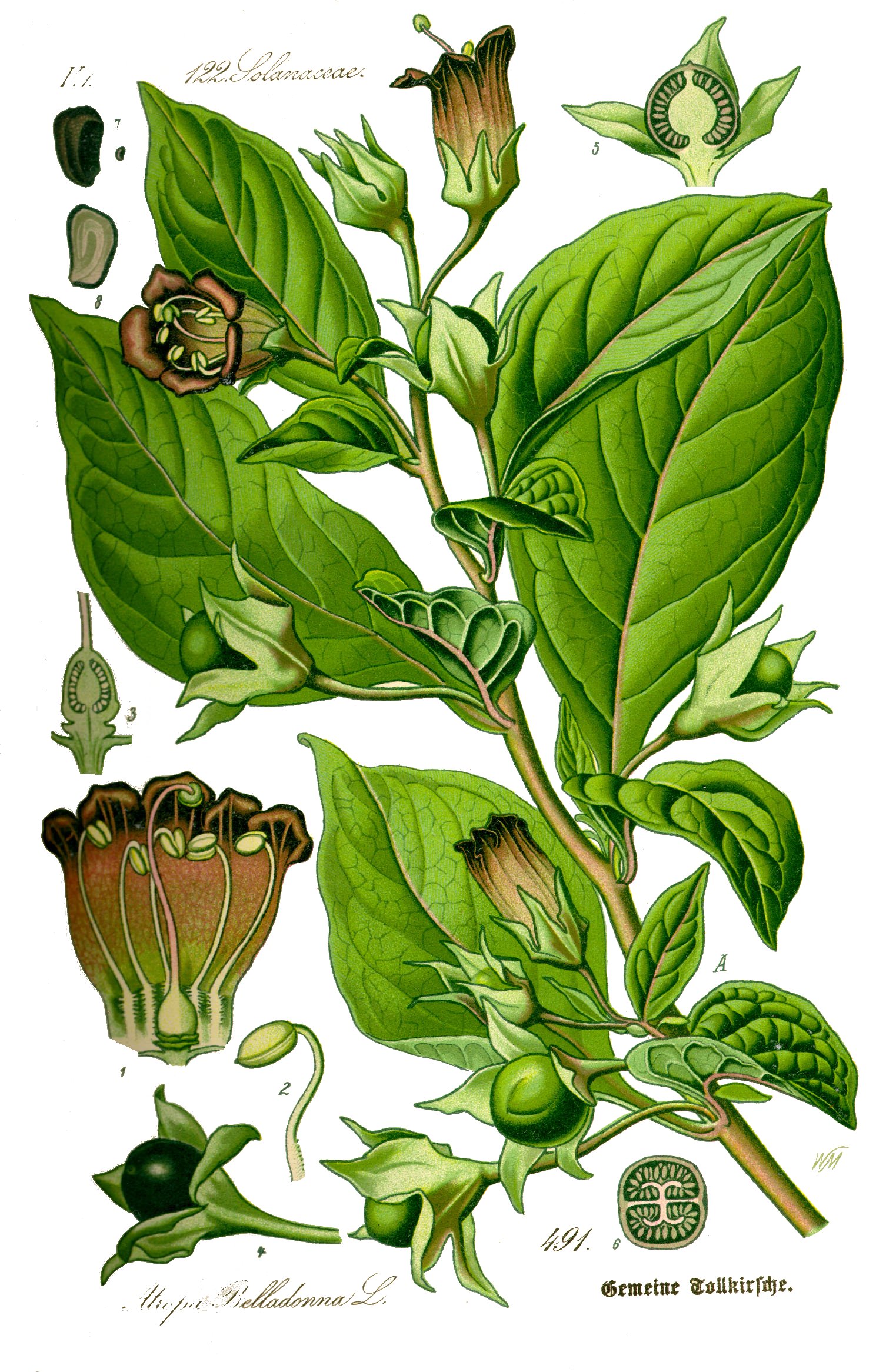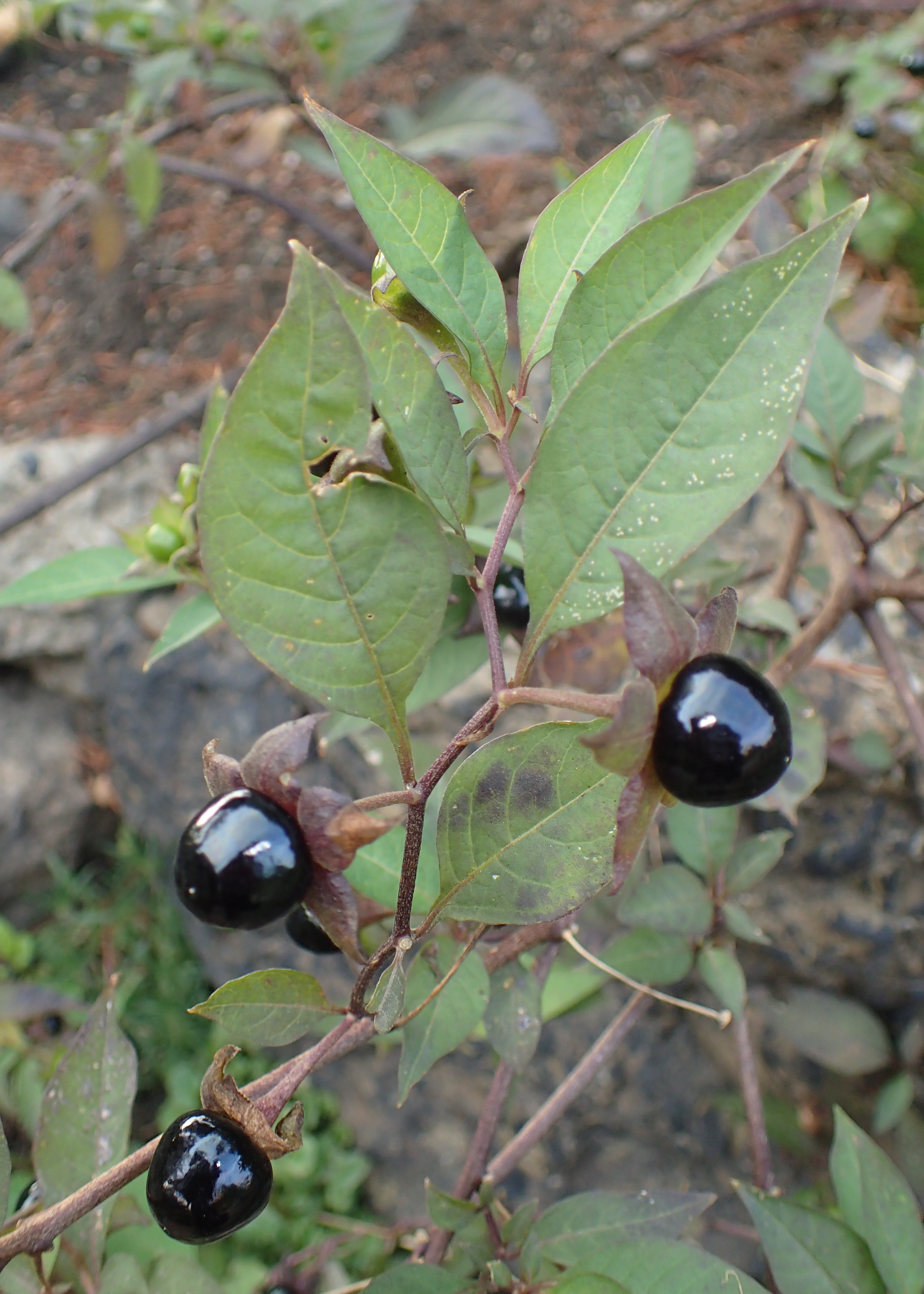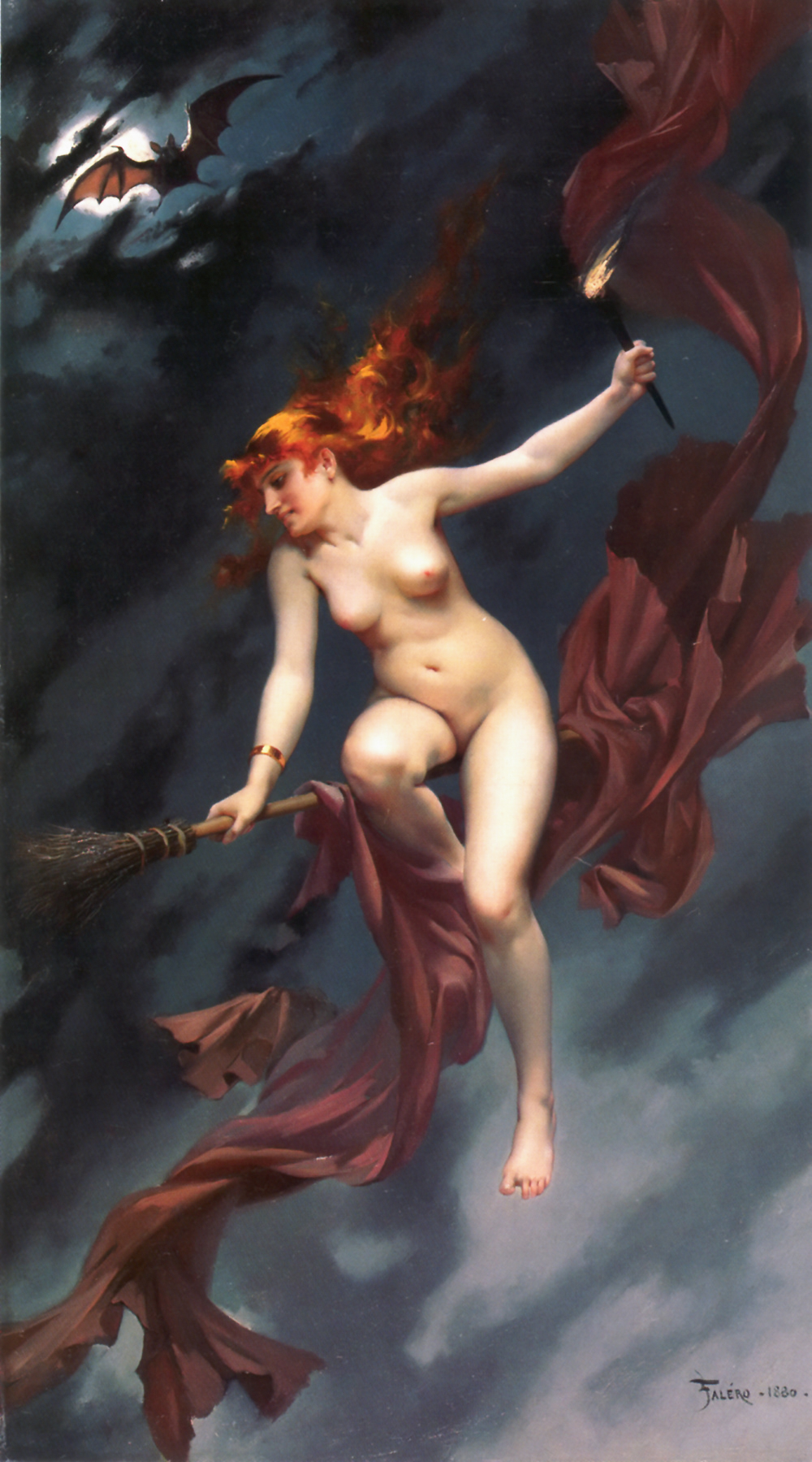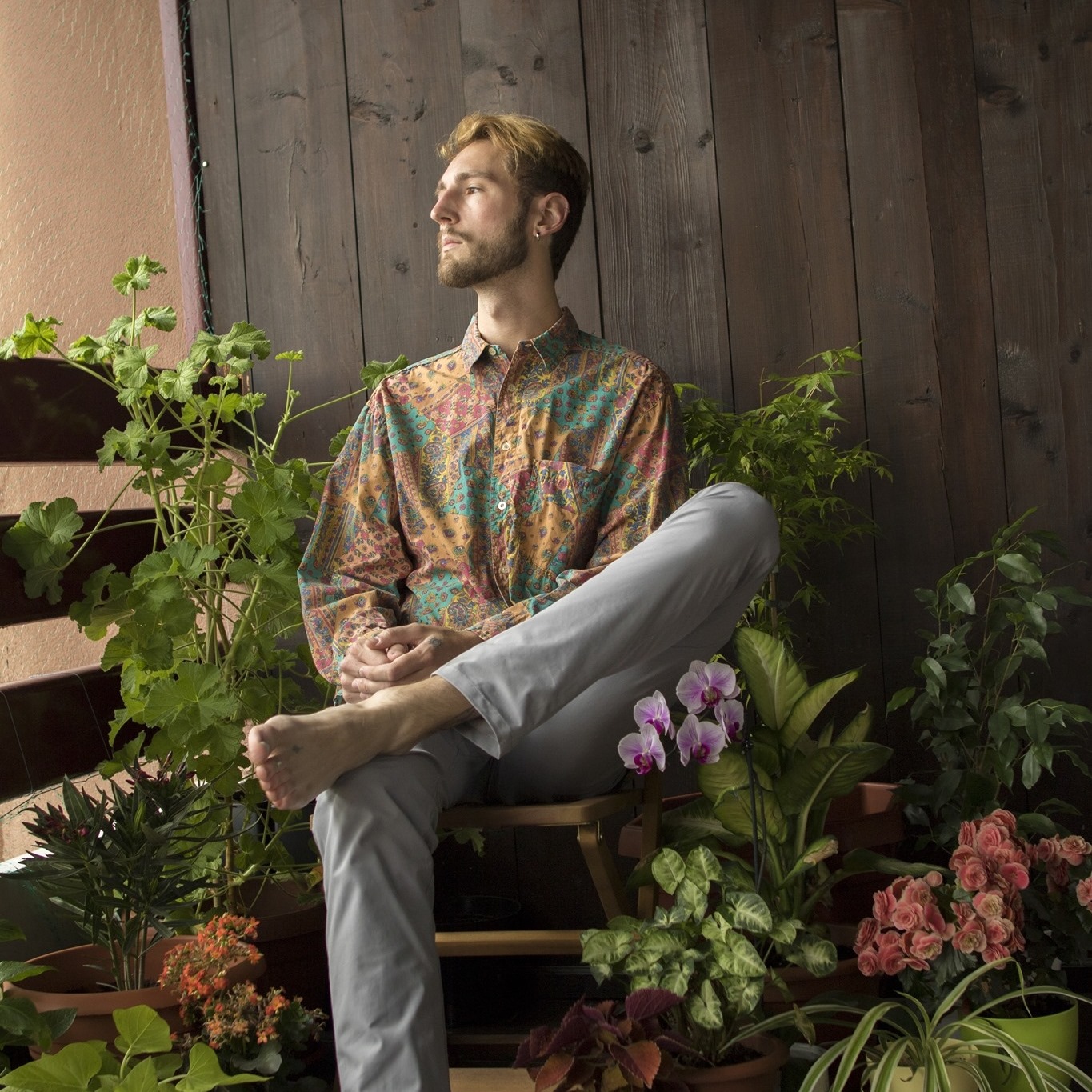Belladonna - Deadly Nightshade / Atropa belladonna L. / Karsten Fatur
Belladonna / Deadly Nightshade
Atropa belladonna L.
Karsten Fatur
The witches' plant
Though many plants exist that both frighten and enrapture, perhaps none provoke such paradoxical associations than Atropa belladonna L. Known in English as "deadly nightshade" or simply as "belladonna," this plant has an involved and complex history with humans. Even in the Latin name for the plant, we see this striking dichotomy. The genus name (Atropa) comes from the ancient Greek name for one of the fates, a trio of ancient Greek goddesses who cut the life threads of mortals, ending their lives (Lee, 2007). While the genus name speaks to death, the species name stands in stark contrast as "belladonna" means "beautiful woman" in Italian, which may refer to its supposed past use by Italian women to dilate their pupils, a sign of beauty at the time (Passos and Mironidou-Tzouveleki, 2016).
This plant is a herbaceous perennial, often found growing in disturbed soils in and around forests and other shaded areas. It grows to be around 1-2 metres in height, and has ovate leaves in a rich green hue. Its flowers boast 5 fused petals that are a deep purple towards the end and yellow towards the base, eventually maturing to its characteristic shiny, blue-black berries. Belladonna is traditionally a European plant, known across most of the continent; in more recent times, it has also been introduced outside of this range, such as in North America (Passos and Mironidou-Tzouveleki, 2016). Though this plant is beautiful in its own right, what makes it truly interesting for ethnobotanists are some of the chemicals inside it. As with other closely related genera such as Datura, Brugmansia, Hyoscyamus, Mandragora, and Scopolia, belladonna contains a range of chemicals known as anticholinergic tropane alkaloids. These are chemicals based on a tropane ring and known to have anticholinergic activity (blocking of cholinergic activity at muscarine receptors in the nervous system) in the human body (Arroo et al., 2007; Maheshwari, 2013). Some of the best-known substances in this group (and the main ones responsible for the effects of belladonna) include hyoscyamine and scopolamine.

Figure 1: A diagram of Atropa belladonna. Image source: Kilom691, Public domain, via Wikimedia Commons.
As you may have guessed from its frightening name, this plant can be extremely deadly and has been responsible for many hospital visits and deaths, both in the past and the modern day (Fatur and Kreft, 2020). Hyoscyamine and scopolamine can cause a range of symptoms in the human body, such as blurred vision (due to the dilation of the pupils), dry mouth (leading to difficulty talking and swallowing), slowed digestion, drying and reddening of the skin, headache, cardiac complications (bradycardia or tachycardia), impaired coordination, restlessness, inability to pay attention, loss of coherence in speaking, delirium, hallucinations, memory disturbance, coma, and sometimes death (Adamse and van Egmond, 2010; Halpern, 2004). Effects generally last for days, while some (like the blurred vision) can last for weeks (Halpern, 2004). If this isn't enough to scare you off of belladonna, consider this: the hallucinations it causes tend to be very intense, lifelike, and dark in nature, often terrifying and traumatising those who have experienced them (Díaz, 2010; Fatur and Kreft, 2021). Though this plant (and others containing scopolamine and hyoscyamine) have been used as recreational substances, they are very dangerous and do not provide the mild distortion to perception and fun experience that people expect from other biological hallucinogens, such as "magic" mushrooms (Psilocybe spp.) (Fatur, 2021).
Despite its dangerous effects (and often because of them!), this plant has a long history of use by humans. Even though it produces such undesirable hallucinations, it was widely used for strengthening wine in parts of the Balkan Peninsula and was known to be taken by bored young boys herding in the mountains of Croatia (Lacković, 2017; Stevanovic and Lukovic, 2014). Though poisonous, correct dosing of belladonna can also produce medicinal effects. As a result, it was widely used as a medicinal plant throughout the ages in Europe, generally for treating pain and respiratory ailments, though it was also used for many other conditions (Kromar, 1979; Lipič, 1834; Popovic et al., 2012; Redžić, 2007; Ulbricht et al., 2004). It has also been used in veterinary medicine (Sobrero, 1975).

Figure 2: The deadly berries of belladonna often look appealing to children and to the unwary adult, and are sometimes mistaken for blueberries and other edible fruits. Image source: Krzysztof Ziarnek, Kenraiz, CC BY-SA 4.0, via Wikimedia Commons.
In contrast to its uses as medicine, belladonna has also been extensively used as a poison, being used in this manner to help capture fish, to poison the food or drink of enemy armies, and on the tips of spears and arrows (Aikman, 1827; Cilliers and Retief, 2000; Gunda, 1967; Mayor, 2015). In the modern day, there is very little remaining traditional use for this plant as a medicine, poison, or recreational drug as safer alternatives have largely replaced it.
Perhaps one of the most fascinating aspects of belladonna is its association with witchcraft. Many believe that belladonna was used as part of supposed "flying ointments," a form of ointment that was believed allow witches to fly off to demonic meetings. Indeed, people have associated belladonna and its close relatives with this since at least the 1400s, with these beliefs having been widespread in Europe (Marjanić, 2006; Piomelli and Pollio, 1994). Not everyone, however, believed in the supposed magical powers of these ointments; some believed that they were created by tricksters and were a fraudulent means of deception (Ostling, 2016). Perhaps the most likely explanation is that medicinal ointments made with belladonna and its relatives were made too strong at times, and that these ointments then ended up intoxicating those using them, leading to the belief they were used as a tool for witchcraft; they may also just have been used as a cheap form of intoxicant for the poor who could not afford alcohol and other recreational substances (Fühner, 1925; Kromar, 1979).

Figure 3: Some believe that belladonna and its close relatives were the cause of our notions of witches flying through the air on broomsticks. Image source: Luis Ricardo Falero, Public domain, via Wikimedia Commons.
Really, this is only the tip of the iceberg when it comes to this plant! It has also appeared in many myths and works of literature and art, and is even kept by some as a garden plant (though beware, the poisons in belladonna can enter through your skin if you touch the plant, and children and pets are known to be drawn to its potentially deadly berries). Some have even associated it and its close relatives with the origins of the belief in werewolves. For more on this fascinating plant, check out some additional reading here.
Now, you may be wondering why belladonna is one of my favourite plants. It can't cure cancer (that we know of), it has caused many deaths and scary experiences, and people have been using it for centuries to violently kill each other. I would say we need to come full circle and go back to what we talked about at the start of this: the inherent paradox of the plant. With names related to death and beauty and with uses that kill and uses that heal, this fundamental oppositional dichotomy is deeply poetic. Not only that, but it ties in very well with the rich and interesting history of the plant. So, though dangerous, I think it's a very cool plant with a fascinating story to tell!
Literature
Adamse, P., van Egmond, H.P., 2010. Tropane alkaloids in food. Institute of Food Safety.
Aikman, J., 1827. The History of Scotland, Translated from the Latin of George Buchanan; with Notes and a Continuation to the Union in the Reign of Queen Anne. Vol. I. Blackie, Fullarton, &. Co., Glasgow.
Arroo, R.R.J., Woolley, J.G., Oksman-Caldentey, K.M., 2007. Tropane alkaloid containing plants - Henbane, Belladonna, Datura, and Duboisia, in: Nagata, T., Lörz, H., Widholm, J.M. (Eds.), Transgenic Crops VI, Section II: Medicinal Crops, Biotechnology in Agriculture and Forestry Vol. 61. Springer-Verlag, Berlin, pp. 2–20.
Cilliers, L., Retief, F.P., 2000. Poisons, Poisoning and the Drug Trade in Ancient Rome. Akroterion 45, 88–100. https://doi.org/10.7445/45-0-166
Díaz, J.L., 2010. Sacred plants and visionary consciousness. Phenomenol Cogn Sci 9, 159–170. https://doi.org/10.1007/s11097-010-9157-z
Fatur, K., 2021. Peculiar plants and fantastic fungi : An ethnobotanical study of the use of hallucinogenic plants and mushrooms in Slovenia. PLoS One 16, e0245022. https://doi.org/10.1371/journal.pone.0245022
Fatur, K., Kreft, S., 2021. Nixing the nightshades : Traditional knowledge of intoxicating members of the Solanaceae among hallucinogenic plant and mushroom users in Slovenia. PLoS One 16, e0247688. https://doi.org/10.1371/journal.pone.0247688
Fatur, K., Kreft, S., 2020. Common anticholinergic solanaceaous plants of temperate Europe - A review of intoxications from the literature (1966–2018). Toxicon 177, 52–88. https://doi.org/https://doi.org/10.1016/j.toxicon.2020.02.005
Fühner, H., 1925. Solanazeen als Berauschungsmittel Eine historisch-ethnologische Studie. Naunyn Schmiedebergs Arch Exp Pathol Pharmakol 111, 281–294.
Gunda, B., 1967. Fish Poisoning in the Carpathian Area and in the Balkan Peninsula. Kroeber Anthropological Society Special Publications 1, 1–33.
Halpern, J.H., 2004. Hallucinogens and dissociative agents naturally growing in the United States. Pharmacol Ther 102, 131–138. https://doi.org/10.1016/j.pharmthera.2004.03.003
Kromar, J., 1979. Strupene Rastline. Založba borec, Ljubljana.
Lacković, Z., 2017. “bunanje”: XX century abuse of atropa belladonna halucinogenic berries in continental Croatia. Psychiatr Danub 29, 379–382. https://doi.org/10.24869/psyd.2017.379
Lee, M., 2007. Solanaceae IV: Atropa belladonna, Deadly Nightshade. Journal of the Royal College of Physicians of Edinburgh 37, 77–84.
Lipič, F.V., 1834. Topografija c-kr. deželnega glavnega mesta Ljubljane z vidika narsvoslovja in medicine, zdravstvene uredite in biostatike. Znanstveno društvo za zgodovino zdravstvene kulture Slovenije, Ljubljana.
Maheshwari, N.O., 2013. Rediscovering the medicinal properties of Datura sp.: A review. Journal of Medicinal Plants Research 7, 2885–2897. https://doi.org/10.5897/JMPR11.1657
Marjanić, S., 2006. Witches’ zoopsychonavigations and the astral broom in the worlds of Croatian legends as (possible) aspects of shamanistic techniques of ecstasy (and trance). Studia mythologica Slavica 17.
Mayor, A., 2015. Chemical and Biological Warfare in Antiquity, in: Wexler, P. (Ed.), History of Toxicology and Environmental Health: Toxicology in Antiquity, Volume II. Elsevier, London, pp. 9–20.
Ostling, M., 2016. Babyfat and Belladonna: Witches’ Ointment and the Contestation of Reality. Magic Ritual Witch 11, 30–72.
Passos, I.D., Mironidou-Tzouveleki, M., 2016. Hallucinogenic Plants in the Mediterranean Countries, in: Preedy, V.R. (Ed.), Neuropathology of Drug Addictions and Substance Misuse. Academic Press, Cambridge, pp. 761–772. https://doi.org/10.1016/B978-0-12-800212-4.00071-6
Piomelli, D., Pollio, A., 1994. A study in Renaissance psychotropic plant ointments. Hist Philos Life Sci 16, 241–273.
Popovic, Z., Smiljanic, M., Matic, R., Kostic, M., Nikic, P., Bojovic, S., 2012. Phytotherapeutical plants from the Deliblato Sands (Serbia): Traditional pharmacopoeia and implications for conservation. Indian Journal of Traditional Knowledge 11, 385–400.
Redžić, S., 2007. The ecological aspect of ethnobotany and ethnopharmacology of population in Bosnia and Herzegovina. Coll Antropol 31, 869–90.
Sobrero, A., 1975. Il culto della mandragora in Romania, in: Eliade, M., Da Zalmoxis, A. (Eds.), Gengis-Khan: Studi Comparati Sulle Religioni e Sul Folklore Della Dacia e Dell’Europa Centrale. Ubaldini Editore, Rome, pp. 180–198.
Stevanovic, Z.D., Lukovic, M., 2014. Ethnobotany and Biocultural Diversities in the Balkans. Ethnobotany and Biocultural Diversities in the Balkans. https://doi.org/10.1007/978-1-4939-1492-0
Ulbricht, C., Basch, E., Hammerness, P., Vora, M., Wylie, J., Woods, J., 2004. An evidence-based systematic review of belladonna by the natural standard research collaboration. J Herb Pharmacother 4, 61–90.
About the author
 Karsten is an ethnobotanist whose research largely focuses on medicinal and psychoactive plants and their uses by humans, as well as European ethnobotany more broadly.
Karsten is an ethnobotanist whose research largely focuses on medicinal and psychoactive plants and their uses by humans, as well as European ethnobotany more broadly.
The Society for Ethnobotany is open to researchers, practitioners, and enthusiasts of ethnobotany and economic botany.
The 2026 SEB Annual Meeting will take place in Montpellier, France, from May 31-June 4th!
If you have an interest in ethnobotany or economic botany you can become a member of the Society for Ethnobotany.
If you are a member of the Society for Ethnobotany and would like to contribute a Favorite Plant please contact Blair Orr, blairorr@ymail.com. (Note: ymail, not gmail.)
